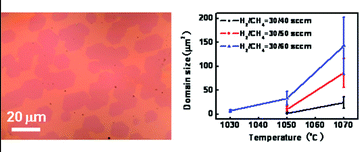Publications
A systematic study of atmospheric pressure chemical vapor deposition growth of large-area monolayer graphene
L. Liu, H. Zhou, R. Cheng, Y. Chen, Y. Lin, Y. Qu, J. Bai, I. A. Ivanov, G. Liu, Y. Huang and X. Duan
J. Mater. Chem. 22, 1498-1503 (2012)

Graphene has attracted considerable interest as a potential material for future electronics. Although mechanical peel is known to produce high quality graphene flakes, practical applications require continuous graphene layers over a large area. The catalyst-assisted chemical vapor deposition (CVD) is a promising synthetic method to deliver wafer-sized graphene. Here we present a systematic study on the nucleation and growth of crystallized graphene domains in an atmospheric pressure chemical vapor deposition (APCVD) process. Parametric studies show that the mean size of the graphene domains increases with increasing growth temperature and CH4 partial pressure, while the density of domains decreases with increasing growth temperature and is independent of the CH4 partial pressure. Our studies show that nucleation of graphene domains on copper substrate is highly dependent on the initial annealing temperature. A two-step synthetic process with higher initial annealing temperature but lower growth temperature is developed to reduce domain density and achieve high quality full-surface coverage of monolayer graphene films. Electrical transport measurements demonstrate that the resulting graphene exhibits a high carrier mobility of up to 3000 cm2 V−1 s−1 at room temperature.
UCLA, Department of Chemistry and Biochemistry
607 Charles E. Young Drive East, Box 951569
Los Angeles, CA 90095-1569
E-mail: xduan@chem.ucla.edu
607 Charles E. Young Drive East, Box 951569
Los Angeles, CA 90095-1569
E-mail: xduan@chem.ucla.edu







